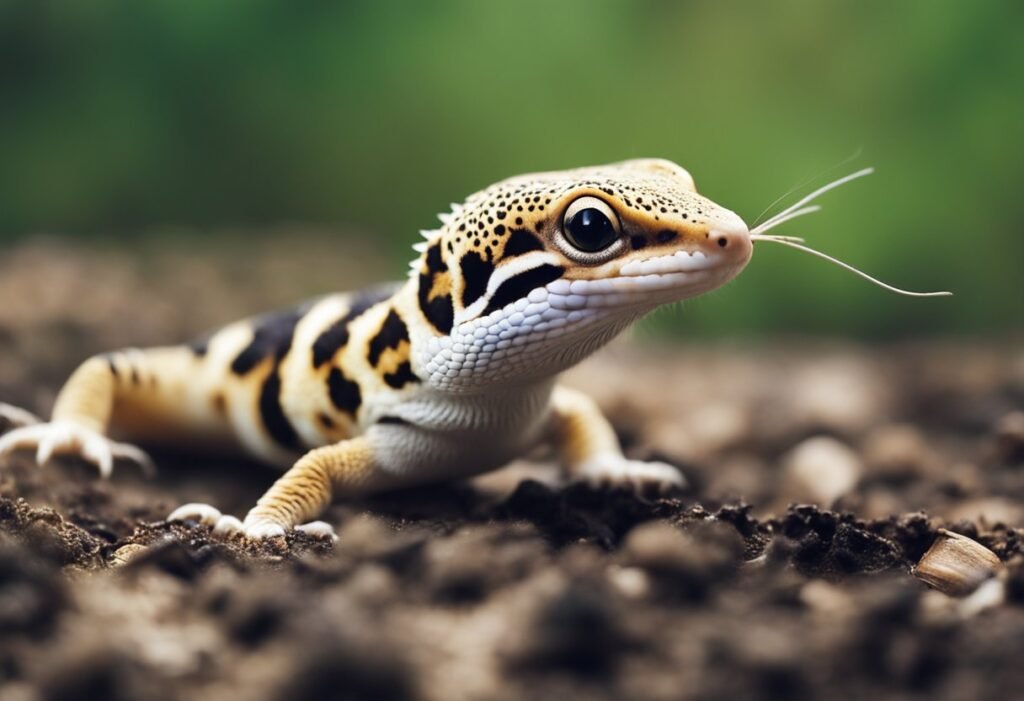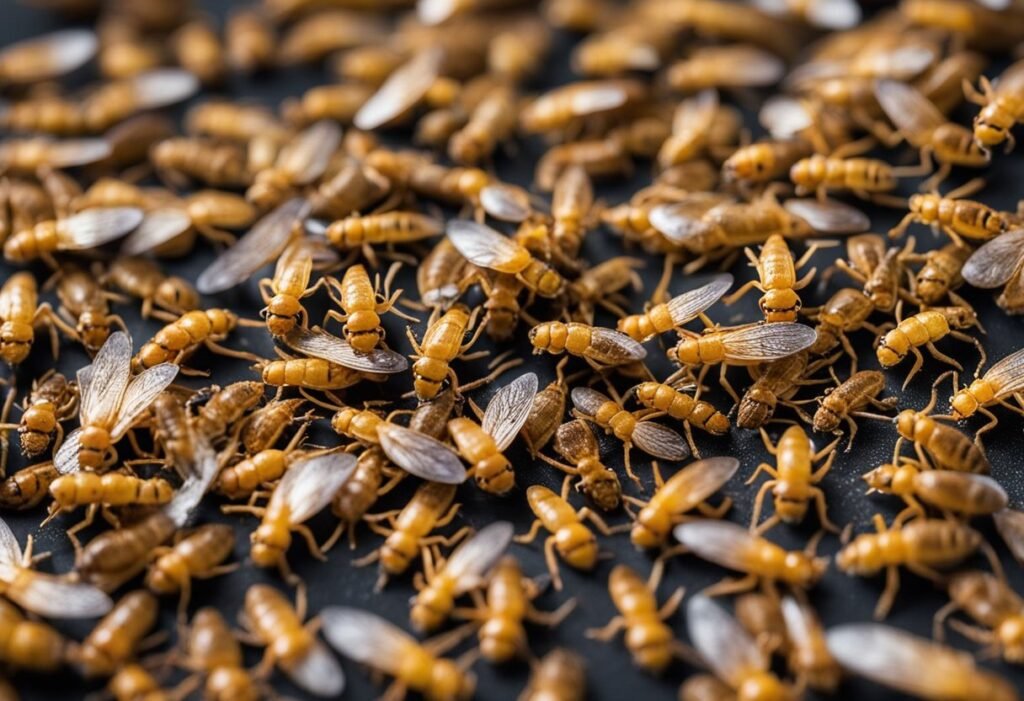Leopard geckos are fascinating creatures that have become increasingly popular as pets in recent years. As with any pet, it’s important to know what they can and cannot eat. One question that often arises is whether leopard geckos can eat dead bugs.

The short answer is yes, leopard geckos can eat dead bugs. In fact, many owners feed their geckos a diet that includes both live and dead insects. However, it’s important to note that not all dead bugs are safe for leopard geckos to eat. In this article, we’ll explore the topic of feeding leopard geckos dead bugs in more detail.
Leopard Gecko Dietary Basics

Leopard geckos are insectivores, meaning they eat insects. In captivity, they can be fed a variety of live insects such as crickets, mealworms, and waxworms. However, some owners may wonder if it’s safe to feed their leopard gecko dead bugs.
Nutritional Requirements
Leopard geckos require a balanced diet to maintain their health. Insects should be gut-loaded, meaning they are fed a nutritious diet before being fed to the gecko. This ensures that the gecko is getting the necessary vitamins and minerals from their food.
It’s important to note that feeding dead bugs may not provide the same nutritional value as live insects. Dead bugs may not have the same nutrient content as live insects, and they may also contain harmful bacteria that can make your gecko sick.
Feeding Behaviors
Leopard geckos are nocturnal and typically feed at night. They have a voracious appetite and will eat until they are full. It’s important to monitor their food intake to prevent overfeeding, which can lead to obesity and other health problems.
When feeding live insects, it’s important to supervise your gecko to ensure they are eating properly and not choking on their food. Dead bugs may be easier for your gecko to eat, but they may also be less stimulating and engaging for your gecko than live insects.
In conclusion, while it may be tempting to feed your leopard gecko dead bugs, it’s important to consider the potential risks and nutritional value. Live insects are the preferred food source for leopard geckos and should be fed a varied and balanced diet to ensure their health and well-being.
Understanding Dead Insects as Food

When it comes to feeding leopard geckos, one of the options is to offer them dead insects. While live prey is often the preferred choice, there are some situations where dead bugs may be more practical. In this section, we will explore the pros and cons of feeding dead insects to leopard geckos, as well as important safety considerations.
Pros and Cons of Dead Bugs
One of the advantages of using dead insects as food is that they are easy to store and transport. You can buy them in bulk and keep them in the freezer until you need them. This can be especially useful if you live in an area where live insects are not readily available. Dead insects are also less likely to carry parasites or diseases, which can be a concern with live prey.
However, there are also some downsides to feeding dead insects. For one, they lack the movement and stimulation that live prey provides, which can be important for keeping your gecko active and engaged. Dead insects also lack the nutritional value of live prey, which can be a concern if you are relying solely on dead bugs for your gecko’s diet.
Safety Considerations
When feeding your leopard gecko dead insects, it’s important to take some safety precautions. First, make sure that the insects are not too large for your gecko to eat. If the prey item is too big, your gecko may choke or become impacted. It’s also important to thaw frozen insects completely before feeding them to your gecko. This will help prevent digestive issues.
Another consideration is the source of the insects. If you are collecting insects from outside, make sure that they have not been exposed to pesticides or other chemicals. Insects from pet stores or online retailers are often a safer option since they have been raised specifically for feeding to reptiles.
In conclusion, while live prey is generally the preferred choice for feeding leopard geckos, dead insects can be a useful alternative in certain situations. By understanding the pros and cons of using dead bugs, as well as taking important safety considerations into account, you can provide your gecko with a healthy and varied diet.
Preparing Dead Insects for Feeding

When it comes to feeding your leopard gecko, dead insects can be a great option. However, it’s important to properly prepare them to ensure your gecko is getting the nutrients they need and to prevent any potential health issues. Here are some tips on preparing dead insects for feeding.
Proper Storage
It’s important to store your dead insects properly to prevent them from going bad. We recommend keeping them in a sealed container in the freezer until you’re ready to use them. This will keep them fresh and prevent any bacteria from growing on them.
Thawing and Serving Techniques
When it’s time to feed your leopard gecko, you’ll need to thaw and serve the insects properly. Here are some techniques to follow:
- Thaw the insects in the refrigerator overnight. This will ensure they’re fully thawed and ready to serve.
- Before serving, you can warm the insects up slightly by placing them in a plastic bag and submerging them in warm water for a few minutes. Be sure not to overheat them, as this can destroy some of the nutrients.
- Once the insects are thawed and warmed, you can serve them to your leopard gecko. We recommend using feeding tongs to prevent accidentally injuring your gecko.
By following these tips, you can ensure that your leopard gecko is getting the nutrients they need from their food and that they’re staying healthy.
Alternative Food Options
Live Prey
While leopard geckos are known to primarily feed on live insects, they can also consume dead bugs. However, it is important to note that feeding your leopard gecko live prey is still the best option as it provides them with the necessary nutrients they need.
Some common live prey options for leopard geckos include crickets, mealworms, and waxworms. It is recommended to gut-load the insects with nutrient-rich foods before feeding them to your gecko.
Commercial Diets
In addition to live prey, there are also commercial diets available for leopard geckos. These diets come in the form of pellets or powders that can be mixed with water to create a paste.
It is important to note that not all commercial diets are created equal. Look for diets that are high in protein and low in fat. Additionally, it is recommended to supplement the diet with live insects to ensure your gecko is receiving all the necessary nutrients.
Overall, while dead bugs can be an alternative food option for leopard geckos, live prey and commercial diets are still the best options for providing them with the necessary nutrients.
Monitoring Your Leopard Gecko’s Health
Signs of Nutritional Deficiencies
As responsible pet owners, we must ensure that our leopard geckos receive a balanced and nutritious diet. A diet that is deficient in essential nutrients can lead to various health problems. Some signs of nutritional deficiencies include:
- Stunted growth or weight loss
- Weakness or lethargy
- Abnormal shedding or skin problems
- Decreased appetite
- Bone deformities or fractures
If you notice any of these symptoms in your leopard gecko, it is important to consult with a veterinarian who specializes in reptiles. They can help identify the specific nutrient deficiency and recommend ways to correct it.
Regular Health Check-ups
Regular health check-ups are essential for maintaining your leopard gecko’s overall health. During these check-ups, a veterinarian can assess your gecko’s weight, body condition, and overall health. They can also check for any signs of illness or disease.
In addition to regular check-ups, it is important to monitor your leopard gecko’s behavior and habits. This can help you identify any changes in their health early on. For example, if your gecko suddenly becomes lethargic or stops eating, it may be a sign of an underlying health problem.
By monitoring your leopard gecko’s health and providing them with a balanced and nutritious diet, you can help ensure that they live a long and healthy life.
Frequently Asked Questions
Is it safe for leopard geckos to consume dead insects?
Yes, it is safe for leopard geckos to consume dead insects. However, it is important to ensure that the insects are not too old or have not been exposed to pesticides or other harmful substances.
What alternative foods are suitable for leopard geckos when insects are unavailable?
When insects are unavailable, leopard geckos can be fed meal replacement powders or commercial gecko diets. These diets should be supplemented with calcium and vitamin D3 to ensure proper nutrition.
Can leopard geckos eat non-insect foods, such as fruits or vegetables?
Leopard geckos are strictly insectivores and should not be fed fruits or vegetables. Their digestive system is not designed to process plant matter, and it can lead to digestive issues.
Are there specific types of worms that leopard geckos can safely eat?
Yes, leopard geckos can safely eat mealworms, waxworms, and superworms. It is important to ensure that the worms are appropriately sized for the gecko and are not too large, as this can cause digestive issues.
Do leopard geckos have a preference for live food over dead food?
Leopard geckos generally prefer live food over dead food. Live insects provide more stimulation and exercise for the gecko, which can help prevent obesity and other health issues.
Are dried insects a suitable diet option for leopard geckos?
Dried insects are not a suitable diet option for leopard geckos. They lack the nutritional value of live or fresh insects and can cause digestive problems. It is important to provide fresh, live insects as the primary food source for leopard geckos.





